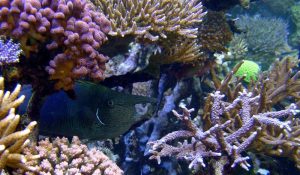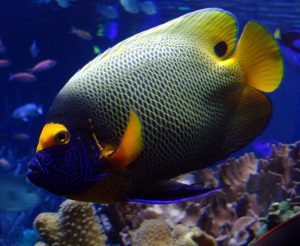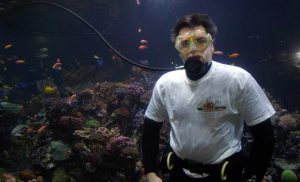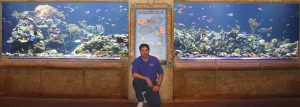Its hard to believe at the time of writing this article but the reef tank here at Atlantis Marine World (AMW) is now over 6 years old and this is the first article I have written about it. I have given many lectures about it, but this is the first attempt to put it into words. I find it difficult to talk about the history of this tank without going into some detail about my reef keeping history. I started reef keeping back in the day when reproducing aiptasia and some valonia growth were cool things, and goniopora were viewed as “easier to keep” as it lived longer than other corals, but what we didn’t realize at the time was they just took longer to die than some of the other corals we were trying to keep.
I grew up on the water always fishing and having fish tanks as a kid. I graduated Southampton College with a degree in Marine Biology back in 1987 and was hired on as an aquarist at the New York Aquarium in Coney Island, Brooklyn, New York. At the time, there was one 90 gallon display tank that was maintained as a reef tank and while some corals did well, others over time faded away. What intrigued me most of all with the tank was watching soft corals like star polyps actually spreading over the substrate and generating new polyps… simply amazing. I was forever hooked and at that point I was a confirmed Coralaholic. My thanks to aquarists Werner Schreiner and Steve Abrams for opening my eyes to the cnidarian world.
So now that I was a Coralaholic and I needed more and more, I then secured a 180 gallon tank behind the scenes and set it up as an experimental reef tank.
Another major leap forward for me was a series of articles by Alf Nilsen in 1990 in some US magazines. To see his amazing reef tank pictures of wonderful corals, and to see that the pictures and corals were not staged was very inspiring. Reading at the time alien words like potassium iodide and strontium chloride had me scrambling up to the old labs and dusting off the brown lab bottles to find such chemicals. For me, it was a great benefit to be both a hobbyist and a professional aquarist, and more thanks go out to reef tank hobbyists who led the way and showed the professionals how to do it right. It should also be noted at this point that Dr. Bruce Carlson was instrumental in marrying the professional and hobbyist realms to the benefit of all. Fast forward to 1993 and I was setting up a 1400 gallon display reef tank at the NY Aquarium, which at the time was a major undertaking.
But the Coralaholic need is a strong one, and to meet that craving, I founded my own public aquarium, AMW, that somehow happens to have a 20,000 gallon reef tank which opened to the public in 2000. The project took almost 8 years from my first rough sketch to ground breaking.
It was within this tank I put the first acropora frag into a flower stem holder, and I take great pleasure in seeing them used around the world now.
Even though it’s a public aquarium, I still view it and the reef tank as my own DIY project, much like any hobbyist feels about their tank. We designed, fabricated, and built everything in-house so there is a great sense of ownership. The reef tank is 30’long x 14’ wide x 6.5 deep (water depth) and contains over 20,000 gallons.
The two acrylic windows measure 6’x 10’ x 3.5” thick. The interior is sealed with a polyurea lining, much like the spray on bed liners for pick up trucks.
‘

The base rock consists of 30,000 pounds of quarried limestone from Wisconsin which dates back 300 million years.
10,000 pounds of live rock was then placed on top of this base rock. The live rock was specially ordered as I needed large pieces, especially the branch rock, with individual pieces weighing as much as 55 pounds. The live rock was held off site for several months to cure, so no major curing took place within the tank. Once the base rock was done to my liking, we then loaded up a pick up truck with some rock and brought it to the aquarium. The live rock was placed around the tank to about one foot high off the bottom, then one foot of water was added.
More loads of rock were brought to the aquarium, then another foot of water was added, and this was repeated till it was too deep to walk around, and the remaining rock was placed using SCUBA. The initial corals and inverts were placed in the tank and nothing was rushed.
Most of the initial fish were tangs, etc that helped with algae control and no algae blooms occurred, mostly due to curing the live rock prior to it going into the tank. The rockwork does not extend to the back wall, and lighting is designed so that it does not emphasize the back wall, which makes the tank appear much wider then it actually is as the back wall fades away from view. Originally the side walls were exposed as well, but over time I grew tired of that look and have since installed vertical walls of live rock using a hammer drill and 3/4 inch fiberglass rod.
The lighting has evolved to include (12) 1000w Daylight metal halides (Venture Cool Deluxe), (8) 1000w Blue metal halide (Venture Color Series BDX), (6) 400w 10K metal halides, and (1) 400w 20k moonlight. There are a few small translucent skylights but they don’t contribute to the corals needs, but do make for a nice subtle wake up period for the fish.
The protein skimmer is one that I built and fusion welded from standard polyethylene containers from Chemtainer. The contact chamber measures 4’ diameter and 6’ tall, with the entire skimmer measuring 10’ 4” tall. It uses a 5hp pump to run a 2” Mazzei venturi and total flow is about 200gpm. 1 gram/ hr ozone from a Del ozone unit is injected into the protein skimmer as well.
Water flow in the tank is a great and never ending challenge. There is a 5hp closed loop that flows ~200gpm., and part of that water goes to a 300 gallon CSD which takes 5 minutes to fill, and empties in 1 minute. This will be upgraded to a 500 CSD in the near future as well. The closed loop also feeds (3) 1.5” Eductors. The Clown tangs love surfing in the outflows of these eductors. Random water flow is achieved by using (5) 1” SeaSwirls and recently I am trying out the newly released WavySea. Other random flow is achieved using a rotating device from the pool industry, and also a 2” unit by OceanMotions. Propellers are a very efficient way to move water, and I use a prototype unit we built that utilizes a ½ hp DC motor and a 5” prop, and at full power it can move ~510gpm. I’m also testing a prototype unit that is a converted MagDrive 18 that moves an incredible amount of water. I also use a floating Scotts Aerator ½ hp prop unit to “storm” or stir up the tank several times/ week. This unit is so strong it can only be used for short periods of time. Additional water flow will be added over time, and it is extremely important to remember that what worked the first few years, probably won’t work in the subsequent years.

I added a second protein skimmer, the ETSS 5000, which has 75gpm flow. I had to modify the air intakes to handle that much flow.
Mechanical filtration is handled by (2) high rate sand filters, with a combined flow rate of 220gpm. As the fish and corals are getting larger, I will be adding additional sand filters to handle the ever increasing bio load and increasing the water flow through them to a total of 420gpm. Detritus accumulation has been a never ending problem in the tank and some more mechanical filtration should minimize that problem.
Water Quality: I use natural sea water from a local New York body of water called Shinnecock Inlet which opens up to the Atlantic Ocean. The water is trucked into Atlantis Marine World and held in a 21,000 gallon holding tank and used in all of marine tanks. Calcium demands are handled by custom built Ca reactors, and all the water that goes through the reactors then goes through a reverse flow reactor filled with Rowaphos to grab the PO4’s released by any type of reactor media used. Upwards of 50gpd of a milky white suspended CaO solution is also dosed. I dose on average 600mls of a 20% SrCl2 solution as well as 600mls of a 1% KI weekly as well, both of which are from ESV. I do have some troughs on the tank that have some macro algae, so I dose 20ml’s 1-2x/ week of iron using the Randy Holmes Farley mixture on Reef Central. Water changes are generally 5-10% per week using the natural sea water. The natural sea water is less then optimum for reef keeping as its low in pH, alkalinity, calcium, etc but the normal daily dosing on the reef tank soon brings the water to acceptable levels. Water temperature is generally between 74-78F, and is maintained by a plate and frame heat exchanger which is connected to our central Geotherm cooling loop.
I also use Phosban and Rowaphos on the tank in custom made Deltec reactors. PO4’s are a major concern on a big tank that is a closed system and while both products do work well, the scale of the tank makes it impossible to use just them for PO4 control. I do believe that the GFO’s grab other nasties that accumulate in reef tanks. Several years ago, many of the corals, anemones and other inverts looked a bit stressed over an extended period of time and I could not figure out why as all the standard water qualities were fine. Phosban had just hit the market and I put some on the tank and within 3 days the corals (both soft and stony), mushrooms, etc that were not extending were relaxed and showing normal polyp extension. The PO4 levels hadn’t changed, so my assumption is the Phosban removed some major irritant that the existing filtration (carbon, protein skimming with ozone) didn’t recognize. For that reason, I believe the use of GFO products are a benefit when reef keeping.
So how does one control PO4’s in a large reef tank with lots of fish that are well fed? Water changes are one way, but when you have a tank this large, even a small 20% water change is 4,000 gallons. Over the past year I have been using lanthanum chloride by Vanson/ SeaKlear. My dosing regiment is 300ml’s diluted in 5 gallons of RO water, and this is then slow dripped over several hours into the sump which goes directly to the protein skimmer. This will on average drop the PO4 level 0.10 ppm overnight. I try to keep my PO4 levels below 0.2ppm and if it gets higher, I see a slow down in coral growth and fading colors. When using LaCl based products, it must be dosed with great care, and I have found the above regimen works well.
PO4’s are a concern and require effort to control them, but luckily NO3’s have been below 1ppm with no work on my end. There must be enough denitrification within the rock and substrate to handle the large bio load and for that I’m grateful.
Most of the maintenance can be done from the top of the tank walkways with a 16’ extension cleaning pole and 10 foot long grabbers and , but about every 10 days or so I need to dive the tank to closely inspect the corals, pruning, planting, etc as well as removing the more stubborn algae on the windows. The dive is done by leaving the SCUBA tank on the tank walkway and using a long regulator hose and extra weights and then carefully walking around the tank.
As time progressed, I began to realize the tank, while mostly focusing on the corals, could also be about the fish as well. Watching some natural behaviors, and given the size of the tank, adult sizes of the fish were being recognized and with that came courtship and regular spawning events. Courtship and spawning events have been observed with the hippo and yellow tangs, a variety of wrasses including the cleaner wrasses, genicanthus angels, cardinal fishes, damsels and clownfish, and the anthias. To date we have not collected any of the eggs. Engineer gobies have spawned and the young have been removed from the tank and reared. I spoke to colleague Kevin Curlee and that lead to an exciting visit from Dr. Eugenie Clark who has been researching the “gobies” in the wild. At the time of writing (8-06), eggs from the damsel Amblyglyphidodon aureus (species?) have been removed and are currently being reared, which is the first documented case that we can find.
The coral growth, especially the sps has been explosive the past two years which has lead to other thoughts on what fish could be considered “reef safe.” I have always been fascinated with the orange spot filefish and have since introduced them to the reef tank. It appears that two mated pairs have formed, with two others staying “single” and at times there are several of them interacting in a non violent manner. They do cruise the tank and graze constantly on the corals, but from what I can see they don’t do any damage, and may actually help stimulate coral growth with their constant “pruning.” They do take prepared foods as well, but even when fed they constantly graze.
While talking about foods, the tank is fed a diet primarily of mysis shrimp, Cyclops, spirulina flake food, New Life Spectrum pellet foods, sandeels, and on occasion frozen rotifers and ESV spray dried phytoplankton. Because I have many large fish, and some of these include questionable reef fish like Emperator, Annularis, Majestic, Regal and Blueface Angels, the tank receives several feeds per day, especially first
thing in the morning. Keeping these fish well fed will help minimize them damaging the reef inverts, as a hungry fish is much more likely to pick on your favorite corals. If I were to do the tank over again, I would have actually made it 4 feet deeper so the fish would have more of a water column for their courtship and spawning and probably make it longer, but probably wouldn’t make it any wider.
As I’ve said, I am a Coralaholic and have no desire to be cured. My reef tank is my baby and mistress in one. Reef keeping is certainly a science, coupled with art and I view the reef tank as something that needs to be constantly designed for both form and function. The corals and fish form a living palette of color to play with, and that palette is truly dynamic by nature. What worked the first few years will probably not work in the subsequent years, and one must always be open to change and adaptation. Not that I play chess, but reefkeeping is much like a really intense chess match. You need to stay at least 20 moves ahead of your opponent just to stay in the game… not to win… but to just hopefully stay in the game. So enjoy your reef tank, but don’t get too comfortable as your “opponent” is just waiting for you to make a wrong move. Stay ahead of your opponent and you both can stay in the game for many years to come.










0 Comments